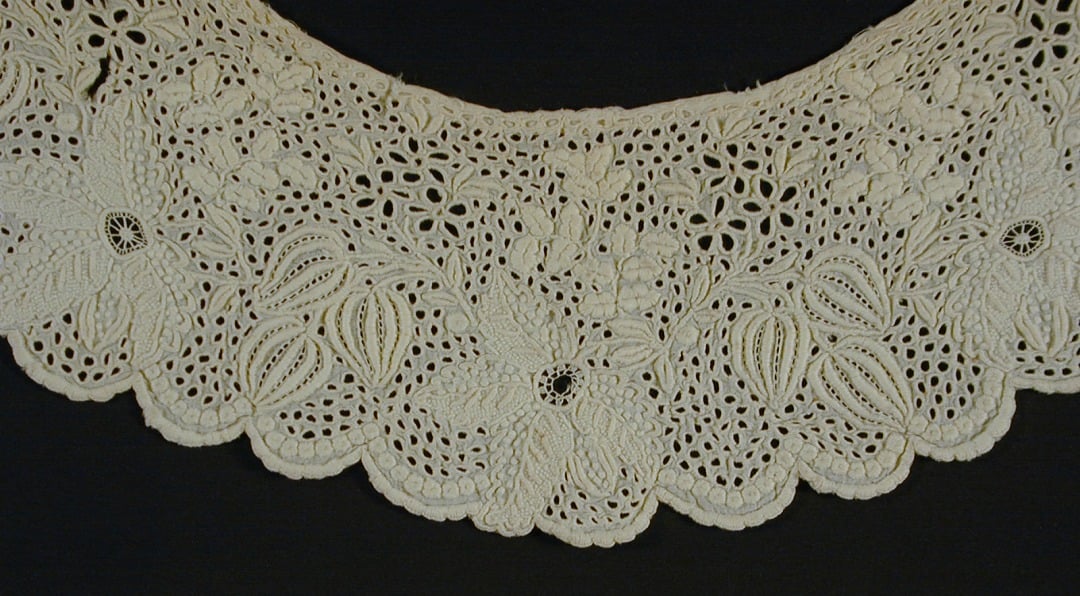
Lace and weddings are a match made in heaven. Hence, it is no wonder that this fabric is the mainstay of wedding fashion and continues to be popular. Lace has recently evolved from romantic, ethereal and wispy forms to crisp, laser-cut wedding gown details. Nevertheless, the charm of this delicate fabric never ceases to impress.
Today, the wedding dress market has plenty of options in lace wedding dresses. There are allover lace gowns as well as dresses trimmed with lace in select locations. The options are numerous with lace details in the bodice, neckline, yoke or sleeves. One of the reasons for this astounding variety is that there are many different types of lace. Also, there are numerous ways in which designers add it to a dress.
Join me today, as I discuss the different factors you should know if you are in the market for a lace wedding gown.
Characteristics of Lace
This decorative fabric may use any of many different types of fibers. Thus, laces are made from Nylon, polyester, wool, silk, cotton and even linen fibers. Better quality laces have small stitches and use fine thread.
The delicate nature of lace makes it susceptible to damage. So, this fragile fabric requires a lot of care. Although it doesn’t unravel, it can lose shape and tear if roughly handled. Traditionally lace was handmade. However, much of the lace available today is sewn by machines.For more details on the general properties of lace, visit the Fabrics International website.
The different details on the lace determine whether it renders a modern or antique look to a dress. Antique lace features significant contrast between the dense and openwork sections. Meanwhile, modern lace has sharp details with similar texture throughout the surface. Antique lace is difficult to create, and hence more expensive.
Most of the lace used in wedding dresses is machine-made. This is usually because handmade lace involves a lot of time and labor. With so much effort involved, it is nearly impossible to make enough lace for an entire wedding dress. Nevertheless, handmade lace is usually seen in smaller sections of wedding dresses. It is used in trims for the neckline, sleeves, or hemline.
Lace by itself renders a whimsical, feminine and romantic look to a wedding gown. Lace also includes embellishments like rhinestones and crystal embroidery, so it is opulent and perfect for a bridal look.
If you look at wedding dresses, you will see more than just one type of lace. The variety of lace determines the overall impact of the gown. Most of the lace in wedding gowns is open-patterned. Seldom do we see wedding dresses that are entirely made from lace. Designers usually use the fabric as an overlay over other heavier fabrics to create a contrasting effect that highlights the intricate details on it.
Let us now look at the different varieties of lace commonly used in wedding dresses.
Types of lace commonly used in wedding dresses.
Bridal dresses with lace effects are very endearing. This fabric’s delicate and wispy nature makes it a great choice for the dreamy, romantic look that most brides seek. The beauty of lace gowns is that it is perfect for most wedding styles. While a short lace dress is ideal for an outdoor garden or rustic barn wedding, full-length sensual lace gowns suit traditional banquet venues. At the same time, lace-embellished dresses blend in with beach venues. Traditional gowns with lace trims are ideal for castles and similar heritage wedding sites.
Here are the different bridal lace varieties commonly used in wedding dresses.
Alencon Lace
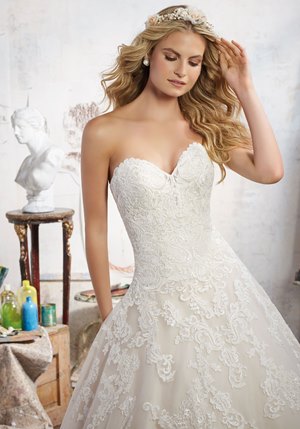
Alencon lace is the queen of laces. It gets its name from Alencon in France, where it first originated. This lace resembles cotton in texture. The raised cording above the pattern characterizes this type of lace. Genuine Alencon lace is incredibly soft. This is in fact the defining factor of how authentic a sample is.
Alencon lace has floral motifs on a net background. Typical designs include Victorian floral details like cabbage roses, daisies, scrolls and medallions. It will usually have an eyelet or bearded edge. For more information on identifying Alencon lace, visit this article on Lady Violette.
Chantilly Lace
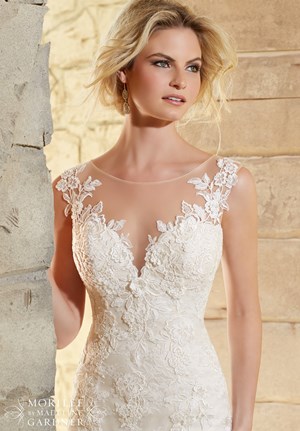
Another type of lace that originated in France, Chantilly Lace, is very delicate. When compared with Alencon lace, this lace usually features larger flowers. There are many folds within the details. This gives the lace a rich, frothy effect. Vintage Chantilly lace is expensive and in high demand. Chantilly lace uses dense and light detailing through suitable half and whole stitches. This creates a shadowy effect. Original Chantilly lace was always black. The reinventions of this classic are white and are now used widely in wedding dresses.
Brocade Lace
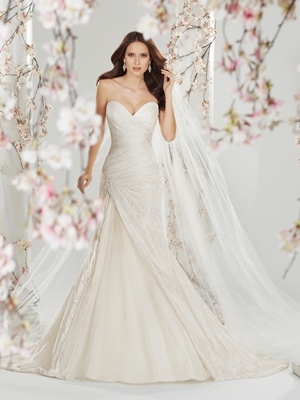
This type of lace has rich fabric weaving and a raised pattern. Metallic gold and silver threads add to its grandeur. Brocade lace may also use coloured silk threads instead of traditional white. Brocade lace is usually manufactured using Shuttle loom weaving. Unlike Alencon and Chantilly laces, brocade lace is thicker and doesn’t possess its characteristic delicate effect.
Embroidered lace
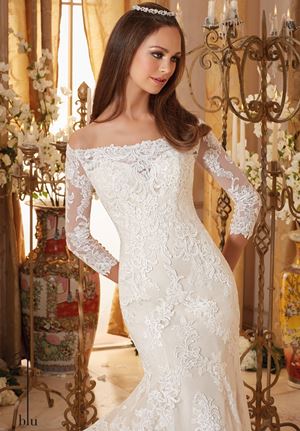
As the name suggests, this lace type has motifs resembling embroidery on a base material. Hence, there is a pronounced three-dimensional effect. Appliques are strewn over the length of the fabric. Commonly used patterns include interconnected floral motifs that stretch over the entire length. The thickness of the base material varies between thin illusion netting and thicker material. For better effect, tulle is usually placed below the embroidered lace layer.
Eyelet lace
Eyelet lace is a unique style with cut-outs in the fabric and trimmed with thread. The sizes and shapes of the holes may vary. It is typically created in cotton, satin or silk. Eyelet lace is popular for Boho weddings, as it has a modern, flirty look. Unlike other types of lace, eyelet lace has a seamless effect. It stands out on its own without a base layer. However, the intricate cut-out designs are prominent when layered over a contrasting fabric. It is not a traditional choice. Hence, it is better suited to modern, casual wedding styles. Although it works for any wedding style, eyelet lace wedding dresses look best at beach and garden weddings.
Guipure or Venetian Lace
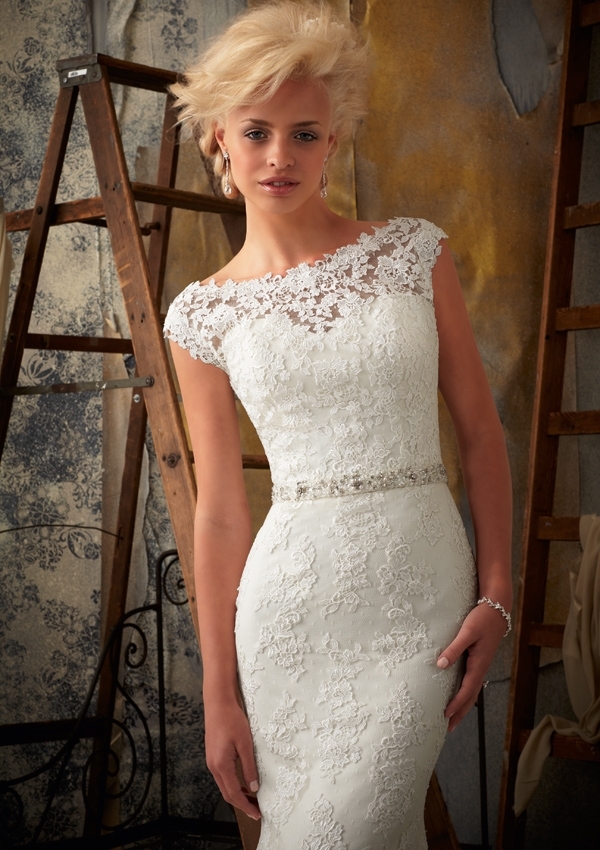
We can quickly identify Guipure or Venetian lace by looking at the links between different motifs. In the case of Alencon and Chantilly lace, the motifs connect through thin mesh or net-like structures. This has a wispy effect. In Venetian lace, dense plaits or thick strands replace this mesh structure. This forms a clear outline for the lace motif. Guipure lace is one of the oldest types of bridal lace. It is still favoured by many designers for its distinct quality.
Now that we know about the different types of wedding dress lace, let us look at how lace transforms a dress based on where it appears. I have also included suitable examples from our collection to illustrate each.
Allover lace wedding dress
Allover lace adorns this cap-sleeve fit and flare gown from the Sans Pareil collection. Wispy floral motifs span the entire length of the gown, creating uniform texture throughout the silhouette. There are no other embellishments on the dress. Despite this, the gown is beautiful in its unique way. Brides can accessorize with many options to achieve the intended look. The floral motifs create a vintage effect, and the dress suits vintage and traditional wedding styles.
Lace trims the tiers and hemline
In this vintage wedding gown from the Mori Lee collection, the tiers in the skirt have lace trims. The embroidered lace appliques on the tiers contrast beautifully against the pale ivory background. The dress has a feminine, youthful vibe, and the lace trim’s very presence enhances the gown’s glamour.
Lace bodice
A wedding dress looks beautiful when the bodice has lace embellishments. This effect contrasts beautifully against a smooth skirt. Alternately, the lace bodice also works well with layered or satin skirts. This mix of textures in the bodice and skirt creates a unique effect. Here is a gown from the Mori Lee collection that achieves the desired effect. The dress has a simple A-line silhouette, but the lace motifs in the bodice contrast beautifully with the soft pleats in the skirt.
Lace yoke and sleeves
Chantilly lace creates a mesmerizing effect for this A-line wedding gown from the Sans Pareil collection. Lace details adorn the yoke and full sleeves. Elaborate swirls spread over the entire misty collar. They extend into illusion sleeves for a slimming effect. This is in direct contrast with the silky satin skirt and textured waistband. Additionally, the slight collar has a scalloped edge with intricate detailing, ensuring that every part of the dress is a work of art.
Scalloped lace hemline
Alencon lace sweeps over the hemline of this wispy Mori Lee Wedding dress. The light, airy fabric forms a beautiful base for the white lace appliques. A scalloped hemline completes the length of this gown in full style. The delicate floral clusters also extend to the rear and into the train, creating a romantic feel.
Lace back detail
Lace appliques frame the cut-out back of this enchanting Mori Lee gown. The re-embroidered appliques appear on a barely-there sheer base, which creates a mesmerizing effect. Scalloped floral edges frame the cut-out. Lace appliques further extend into the skirt and thin towards the pleated layers. The light breezy sheer layer stands out against the off-white layers below it in the fully gathered skirt. Although the lace back features simple details, it is the statement feature of this delightful bridal gown.
Embellished lace details
We spoke earlier about how embellishments on lace add luxury and elegance to a wedding gown. Lace appliques in this Sophia Tolli gown have beautiful crystal and bead details. This adds an opulent touch to the gown. While the golden and silver hues add shimmer and shine, they also create a gently textured finish that accentuates the bridal effect of this gown.
Irrespective of whether a dress has sparse lace details or appears throughout the entire length of a wedding gown, this classic element is bridal in every way. The charm of this bridal element cannot be achieved by any other fabric, and hence it will continue as a bridal staple in years to come.
Apart from wedding dresses, lace is also an essential element in veils used by brides. The wispy nature of this fabric and its fluttering feel is just right to complete the bridal trousseau. Furthermore, lace is also typical in wedding garters, as trims for the bridal bouquet and neckpieces. Finally, many brides make handkerchiefs and bouquet embellishments with lace from heirloom wedding gowns is often made into handkerchiefs and bouquets by brides, as their something old.
Best for Bride has a fantastic collection of lace wedding gowns. Browse through all our designer collections and you are sure to find a wide range of gowns that suit your vision. In addition to this, you can also find enchanting lace dresses in our bridesmaids collection and dresses for special occasions. Visit our dress gallery today to explore all the different options available to include this heirloom-quality style element in your big day.


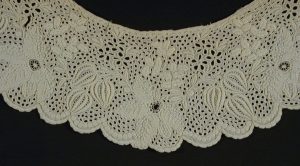

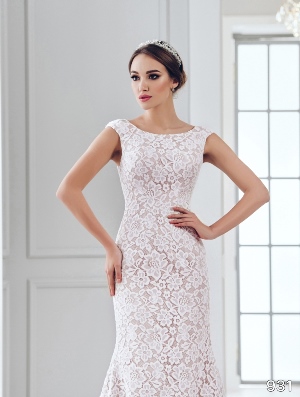
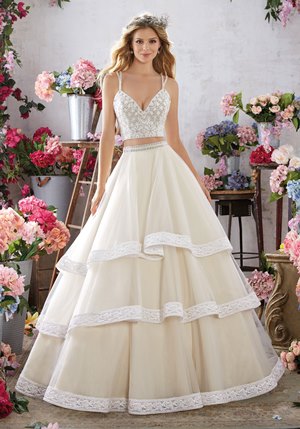
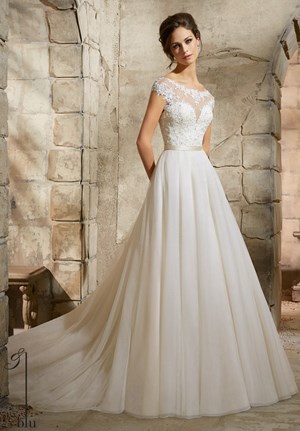
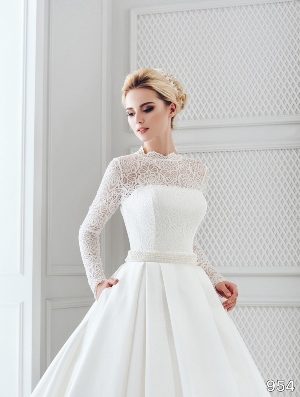
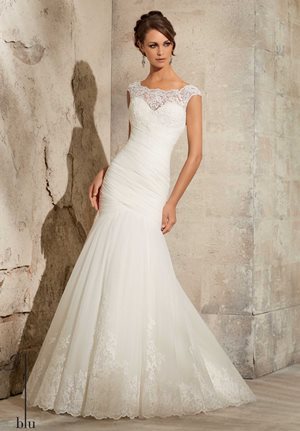
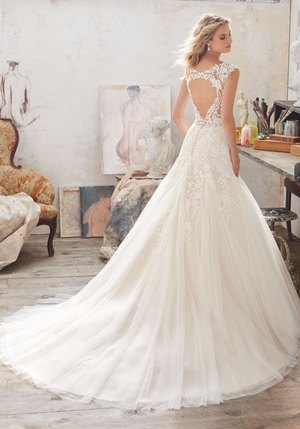

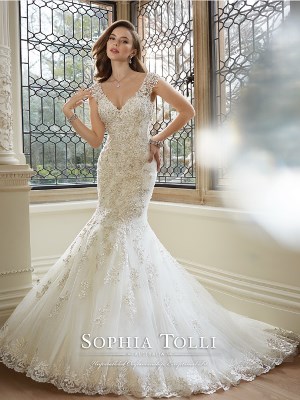










Lace is really my favorite. I have at least 4 dresses narrowed down right now and 3 of them have some form of lace incorporated in them.
So, what you are saying is that if I want to save a little money on my wedding dress decision, I should stay away from lace?
Lace is nice in some instances, but sometimes it can be a little over done, don’t you think? Maybe its not as modern as we all want it to be.
I want a lace type wedding dress for sure. I was not aware that you could have so many different designs. This is going to make my decision a little harder. Bummer.